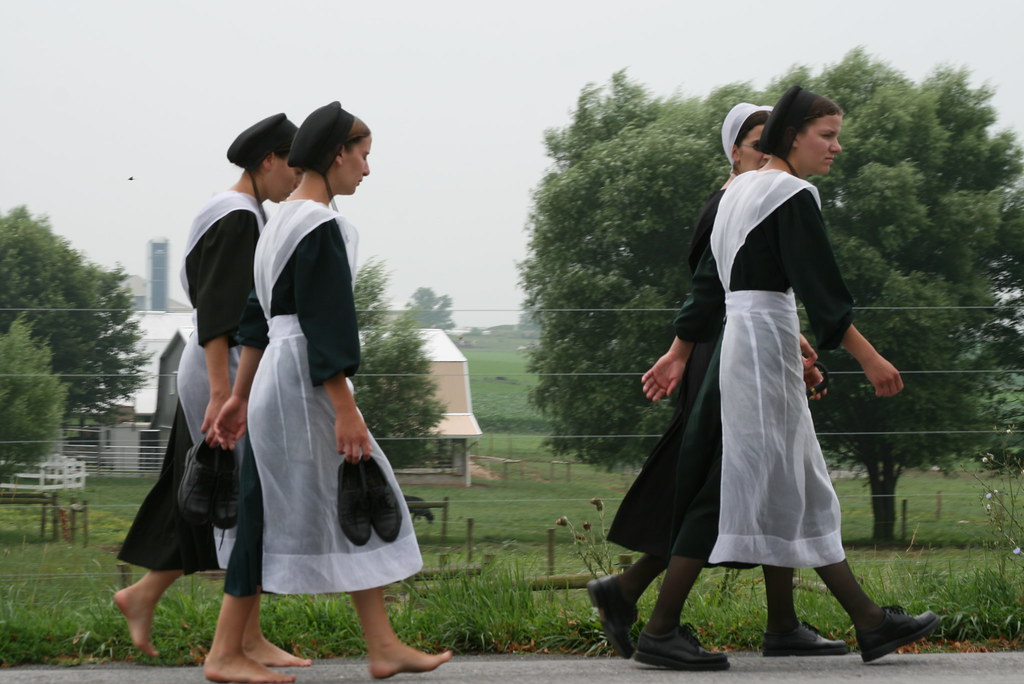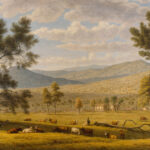The following is excerpted from Chapter 4 of the new book Are We All Cyborgs Now? Reclaiming Our Humanity from the Machine by Joshua Pauling and Robin Phillips.
When I was a high-school teacher, I would share little bits about my family life with my students. They were fascinated by my home—what to them, sounded like a living museum. As little stories would come out from time to time, my students were dumbfounded that we didn’t have cable or satellite TV, a microwave, or the internet, and that my wife and I had only flip phones at the time. One student asked with concern in her voice, “How are your kids going to learn without TV or devices?” After seeing my flip phone that was over a decade old, another student said, “Hey Mr. Pauling, the dinosaurs are calling; they want their phone back.” That was a good one. It all led to good laughs and, honestly, it helped build a certain sense of rapport and respect in the classroom. I was weird enough to seem worth listening to.
During these rabbit-trail discussions, one of the most frequent questions from students was if I was Amish. I always chuckled, since I had electricity, a car, a computer, and many other home appliances of the modern electrified home. Furthermore, I didn’t wear any of the distinctive garb, didn’t have a beard, and there was no horse and buggy in the school parking lot. But somehow, they associated some of the choices my family was making about technology in our home with an Amish lifestyle. Of course, they had little conception of the intricacies of Amish culture or the differences between various Amish, Brethren, or Mennonite sects. But in their minds, the term Amish stood-in for something that seemed weird or backward, outdated or old-fashioned.
In much contemporary discourse at the popular level, the term Amish functions primarily as a slur against those who dare to doubt the sacred narrative of technological progress. But baked into the popular usage of the term are faulty assumptions and misunderstandings about Amish communities, and a deep ignorance of the rationale behind their actions. The term has become nothing but a straw-man, which easily gets knocked over and steamrolled by the momentum of the technological machine.
In what follows, I’d like to steel-man Amish perspectives on technological progress and the necessity of analyzing specific technologies, so we can glean some of their hard-fought wisdom. It is well beyond the scope of this chapter to embark upon a full-scale analysis of Amish culture. Nor am I setting out to endorse every aspect of their communities. But what I am trying to do is help us realize that they are neither dumb nor shortsighted, and that it’s time to retire such unfounded and misleading caricatures.
The Riddle of the Amish
For my undergraduate degree, I attended Messiah College (now Messiah University) in central Pennsylvania. Located right on the fringes of Amish country, Messiah is a school with Anabaptist roots. One of the ways this came through was in the research interests of some of the faculty who spent significant time with Amish, Mennonite, and other Anabaptist communities. One faculty member in particular was Dr. Donald Kraybill, who served as provost at Messiah from 1996 to 2002, in addition to his many years as professor at other universities. Kraybill has written nearly fifty books on a variety of topics related to the cultures and subcultures within this world. When I enrolled in a Master’s program at Winthrop University, I met Dr. Mark DeWalt, another professor with deep connections to Amish and Mennonite culture. DeWalt, too, had been studying and spending time with such groups for decades, even in some of the same circles as Kraybill. By this point, I had learned too much to fall prey to the simplistic stereotypes about the Amish. There was something enduring and captivating about these groups that, though still hard to fully grasp, deserved our respect. Kraybill puts it this way in his book What the Amish Teach Us:
The Amish have much to teach us. It may seem strange, even surreal, to turn to one of America’s most traditional groups for lessons about living in a hyper-tech world—especially a horse-driving people who have resisted ‘progress’ by snubbing cars, public grid power, and even high school education. Nonetheless, the Amish deserve a hearing. Their wisdom confirms that old turns new again. (vii)
What Kraybill finds most intriguing is how Amish ways both disturb and disrupt. If we actually take the time to reflect upon their lifestyle, we find a powerful example of the fact that something different is possible, that you don’t have to participate in all the procedures of progress to be happy, that the power of the machine can be limited and circumscribed; that maybe some of our choices are actually the foolish ones. Kraybill writes,
[The Amish] disturb some assumptions that I take for granted. They disrupt my old habits, my predispositions, and my fixed understandings of how I think the world works. They certainly uproot my a priori assumptions about progress and prod me to question why I do what I do. In this sense, the Amish are silent social critics—offering a critique of modern culture that is intellectually provocative yet always practical. (x)
This is especially true when considering their relationship to technology, which Kraybill calls a riddle of sorts. But once we take a step inside and see their rationale why, for example, they might allow their members to pay to ride in a car but not own a car, or why they might allow a phone to be installed in a place of work, but not in their home, the riddle of what many see as hypocritical, inconsistent, or old-fashioned begins to make sense.
The key to unlock the riddle, in Kraybill’s view, is to realize that the Amish are negotiating with modernity in three ways: they accept, they reject, they bargain. They might reject “radios, televisions, high school, church buildings, and salaried ministers,” Kraybill notes, but accept “small electronic calculators and artificial insemination of cows. And more recently…LED lights on buggies, and battery-powered hand tools” (3). Then, there also is bargaining. One way they bargain with modernity is by “Amishizing” certain technologies or techniques, for example “neutering” computers (stripping WiFi, video games, internet access, etc.), or creating a school curriculum that reflects Amish values and traditions. Another form of bargaining is found in the Amish distinction between access and ownership of certain technologies. An Amish person may pay someone for a car-ride to work, but may not own a car. The logic here is that ownership of a car fosters a sense of autonomy and fragmentation that will eventually fracture the community, while access to a car for specific approved tasks can be salutary or necessary. This type of negotiating is different from one Amish sect to another, but the principle remains the same. “It’s a way of mediating social change, of arresting assimilation into American society,” Kraybill explains, that “enables the Amish to protect their traditional identity while still reaping some of the fruits of process. It keeps the world at bay, while at the same time partaking of some of the world’s achievements. The Amish aren’t intimidated by modernity. They engage it, scrutinize it, and screen it—refashioning it to serve their community” (4-5). In The Amish, Kraybill et al. explain it well:
The Amish, arguably more than any other group in America, have tried to domesticate technology so that its potent force does not overwhelm or cripple their culture. Their effort has been moderately successful for more than a century, but only because it has been a collective project. The Amish offer a profound example of one group’s deliberate attempts to modulate the pervasive power of technology to shape the character of individual and corporate life. (313)
Perhaps to put it most simply, the Amish aren’t anti-technology; they are pro-community. And here I think we find one of the most important lessons from the Amish. Namely, the necessity of collectively interrogating each new technological device or advance with specific questions: What will it do to the community? What will it do to the family? What will it do to the sacred precincts of the home? And, what will it do to me? Such interrogation is not done at the individual level for each person to determine on their own, but by the community at large. The wisdom of the group is pooled in answering these questions. Such intentional collective decision-making and communal discernment are foreign to the American way of the self-made man and independent woman. But their example is a corrective to what has become a corrosive and destructive form of individualism in our lives. The Amish further show us not a set of arbitrary distinctions about technology, but an honest evaluation of each technology to determine if it leads to flourishing. Cal Newport’s perspective in his book Digital Minimalism is a fitting conclusion here:
The Amish, it turns out, do something that’s both shockingly radically and simple in our age of impulsive and complicated consumerism: they start with the things they value most, then work backward to ask whether a given new technology performs more harm than good with respect to these values….At the core of the Amish philosophy regarding technology is the following trade-off: The Amish prioritize the benefits generated by acting intentionally about technology over the benefits lost from the technologies they decide not to use. Their gamble is that intention trumps convenience—and it is a bet that seems to be paying off. (51-53)
Indeed, Newport is right; it is a bet that seems to be paying off. Amish population continues to grow (a 116% increase since the year 2000) and communities are spreading into new states (including Colorado, Nebraska, New Mexico, South Dakota, Vermont, and Wyoming). Since the Amish don’t tend to proselytize, this growth is in large part organic and natural, through new births and an extremely high retention rate that has increased to around 90% at a time when other Christian denominations are shedding members at record numbers.
The Wisdom of Communal Discernment
This little snapshot of the Amish reveals that they are not outmoded simpletons or sticks-in-the-mud who fear new machines. While there are many things we could critique about Amish communities, they do provide an intriguing example of discernment and foresight regarding the unintended consequences of technological “progress.” And we ignore their wisdom to our own peril. While there are limits to the approaches they employ, there are valuable lessons to learn from them.
One of the lessons most relevant today is the need for forms of communal discernment. Living by a set of common principles and practices that we inherit or decide upon together as families or communities has a long history—and I don’t necessarily mean the obvious examples of monasteries, religious orders, or commune environments. In our society that prizes individual autonomy so highly, communal discernment may seem a hard-sell at first, but we all deeply crave ordered limits as they enable us to flourish within healthy boundaries and avoid the paralysis of too many choices and too much freedom.
The Amish also show us the importance of not ceding all our embodied human agency to outside forces, whether, governments, managers, or machines. Their perspective is not that there is no place for machines or technological advancements, but rather, that consideration should be made for how such changes impact our humanity, our families, and the structure and stability of our communities. Alternative structures and patterns of living are possible, and I find their example on this front inspiring. Individuals and communities can do something, especially when they agree to work together on these matters.
What the Amish understand perhaps more than we do is the necessity of maintaining and protecting domains of embodied human agency in our lives. Today, we’re hard-pressed to find any domains that aren’t infiltrated or taken over by the digital machine. Is there any task we do that isn’t somehow related to it, somehow connected to a device or the internet? Take cooking and baking—have the fridge and the stove become another portal to Siri or Alexa, another techno-tentacle of the internet of things? What about driving—has it too been taken over by automation and algorithms, computer chips and GPS? Or, consider exercise and fitness—has it been colonized by Fitbits, Apple Watches, and Earbuds as yet another extension of the digital machine? You get my point. Honestly, what domains of embodied human agency are truly left that are untouched by digitality?
When we cede agency, our sense of alienation grows. It will take resilience, boldness, risk, and working together to carve out ways to still live as creatures in a world where it seems easier and more glamourous to merge with the Machine. But the Amish give us hope and courage that you don’t have to comply, and that there might be a better way. Amish communities are not just against things; they are also for things. They don’t just say no to something; they said yes to something else. And that something else—that sense of community, wholeness, embodied work, and in-person relationship—is looking more intriguing each day.
The preceding is excerpted from Chapter 4 of the new book Are We All Cyborgs Now? Reclaiming Our Humanity from the Machine by Joshua Pauling and Robin Phillips.
Image via Flickr







1 comment
Cory Anderson
I was glad to come across your new book, which I found by way of this chapter on the Amish. Your interest in learning from Amish practices is understandable, as their way of life often seems to offer an intriguing contrast to many aspects of America’s most visible cultural trends. However, I’d like to share some recent perspectives that might prompt a fresh look at how we understand Amish life.
Donald Kraybill’s work, which you’ve drawn from, has been incredibly influential in shaping public perceptions of the Amish. However, one scholar has characterized Kraybill’s depiction of the Amish as a “smurf village,” an apt analogy. Indeed, recent scholarship, including my own, suggests that his approach pitches to what people want to learn from the Amish and, inadvertently, introduces confirmation bias into interpretations of the Amish experiences.
The idea of Amish people constantly “negotiating with modernity,” for instance, can create an impression of a unified Amish approach to contemporary challenges that is based on reasonable logic. In reality, Amish individuals often have nuanced and uneven views on issues like technology use, education, and community life. When discussing these issues, any given individual may be pro-active but may also be reactive or even passively crowd-minded.
Consider, for example, the portrayal of Amish attitudes toward technology. While it’s true that many Amish individuals will discuss the impact of new technologies, the decision-making process and outcomes can feel like a roll of the dice, depending on who says what when and whether opposing parties (be it pro- or anti-adoption) can be silenced or talked down. Similarly, the concept of submission to community will, while theoretically important in Amish theology, doesn’t capture the full range of reactions individuals exhibit toward authority. This, even, assumes different types of authority can even be clearly identified and relative authority weighed against each other. There are bishops, but there are also opinion leaders and business owners, for example.
Ultimately, overwhelmingly positive stereotypes of any populations can put undue pressure on that population to perform to near perfection. Indeed, the strongest condemnations of the Amish I read tend to point out their contradictions in ways that play off how Amish do not live up to what they claim to be. In reality, negative stereotypes are actually fueled by positive stereotypes, neither of which represents any coordinated effort on the part of the Amish to represent themselves to non-members.
These nuances don’t diminish the value of taking note of what we appreciate about other populations. However, it does invite us to approach such learning with greater awareness of complexity. Rather than seeing Amish life as a straightforward alternative to problems we call “modern”, we might consider that Amish people, like all other people, face their own in-group challenges.
If you’re interested in exploring our critiques further, here are two studies that have raised questions about “what Amish can teach us”-type perspectives associated with Kraybill. While incorporating these considerations into your book may no longer be possible, I hope it can serve as a resource for future interpretations of Amish people’s agency and interactions with technology.
“A Critical Appraisal of Amish Studies’ De Facto Paradigm, ‘Negotiating with Modernity’” by Cory Anderson.
https://coryanderson.org/a-critical-appraisal-of-amish-studies-de-facto-paradigm-negotiating-with-modernity/
“The Functionalist Problem in Kraybill’s Riddle of Amish Culture” by Michael Billig and Elam Zook.
https://ideaexchange.uakron.edu/amishstudies/vol5/iss1/4/
Comments are closed.